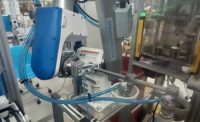Blood gas analyzers measure gases dissolved in the blood, such as oxygen and carbon dioxide. Such information is vital when caring for patients with critical illnesses or respiratory infections, such as COVID-19. These analyzers rely on various disposable cartridges to process blood samples. Millions of these cartridges must be assembled each year.
A blood gas analyzer works by pumping a blood sample through a measurement cartridge, which has multiple sensors to measure pH and the partial pressures of oxygen and carbon dioxide. The bicarbonate concentration is also calculated. Many blood-gas analyzers will also report concentrations of lactate, hemoglobin, several electrolytes, oxyhemoglobin, carboxyhemoglobin, and methemoglobin. These results are usually available for interpretation within five minutes.
These cartridges last for 28 days or a specific number of samples.Once a sample has been analyzed, the sample path must be cleaned before the next sample can be analyzed. This is done with a “wash/waste cartridge,” which has a cleaning fluid and bag to capture the waste. This is then disposed of after nine days or a certain number of samples.
Once a sample has been analyzed, the sample path must be cleaned before the next sample can be analyzed. This is done with a “wash/waste cartridge,” which has a cleaning fluid and bag to capture the waste. This is then disposed of after nine days or a certain number of samples.
RNA Automation Ltd., a systems integrator in Birmingham, UK, recently designed and built an multistation system to automate assembly of wash/waste cartridges for blood gas analyzers. The customer, a global medical technology company, had previously been assembling the cartridges manually.
RNA’s system does not do away with manual labor entirely. Rather, automation and people work together at the same time within a limited workspace. The efficient integration of robots and vision into the assembly line adds significant value due to their reliability and repeatability, resulting in increased throughput and productivity.
At the start of the line, an operator loads cartridge bases through a poke-yoke aperture onto a two-lane declined conveyor. The cartridge bases are taken down a track to a stop, where they are picked and placed into a nest on a pallet-transfer conveyor. The vertical axis of the pick-and-place unit is pneumatic actuator, while the horizontal axis is a servo-driven actuator.The pallet-transfer conveyor is a recirculating loop. Various mechanisms ensure that the pallets are precisely located at each assembly station.
At the start of the line, an operator loads cartridge bases through a poke-yoke aperture onto a two-lane declined conveyor. The cartridge bases are taken down a track to a stop, where they are picked and placed into a nest on a pallet-transfer conveyor. The vertical axis of the pick-and-place unit is pneumatic actuator, while the horizontal axis is a servo-driven actuator. The pallet-transfer conveyor is a recirculating loop. Various mechanisms ensure that the pallets are precisely located at each assembly station.
The pallet-transfer conveyor is a recirculating loop. Various mechanisms ensure that the pallets are precisely located at each assembly station.
At the next station, septa are fed and orientated by two vibratory bowl feeders and are then picked and placed into the housing. A vision check confirms that the septa are in the correct port (they are color-coded), that they are completely seated within the cartridge, and that a red tab is present. A sensor checks that the tab is correctly in place.
An operator manually loads and fits a waste bag before pressing a two-finger start, which enables a press to extend and push a clip into the cartridge housing. The press measures the force applied with reference to the distance travelled by the press to ensure the waste bag has been loaded and fitted correctly.
At the next station, an operator manually loads and fits a wash bag and supports before actuating a whisker switch for the pallet to be released to the next station. Then, a vision system checks that the top half of the wash and waste bags are within the perimeter of cartridge base.
At the next station, lids are loaded by an operator into one of two magazine drawers. The magazines can be topped up independently. The magazine, once returned within the cell, is picked from the top of the stack by a six-axis robot and placed into a datum station. Once the lid is accurately located it is picked again by the robot and assembled to the cartridge base. Once fitted, a presence check for lid ‘tabs’ is completed.
Assembled cartridges arrive underneath a label applicator, where a label is printed and applied to the cartridge. The sides of the label are wiped down, and then a vision sensor performs an OCR check and a test scan to check the bar code.
Once assembled, cartridges are picked from the pallet and placed onto an outfeed gravity track, where they travel to an off-load area.
If a failure is detected at any station, no further value is added to the assembly. The assembly continues to index around to the off-load station, where it is placed into the failure lane. This lane is accessed at the back of the pack station, so that it’s completely isolated from the operator who is accessing good cartridges. Failed cartridges can be removed from the cell without interrupting production.
At the packaging station, an operator offloads cartridges and loads them into either a single or quad box. The box is then loaded into the printing drawer and a two-hand start is activated for the drawer to retract into the station. Inside the station the box is automatically located to a datum position, a label is applied, and the label position and bar code are checked. The operator then activates the two-hand start again and the drawer opens for the operator to remove the box.
For more information on automated assembly systems, visit www.rnaautomation.com.








